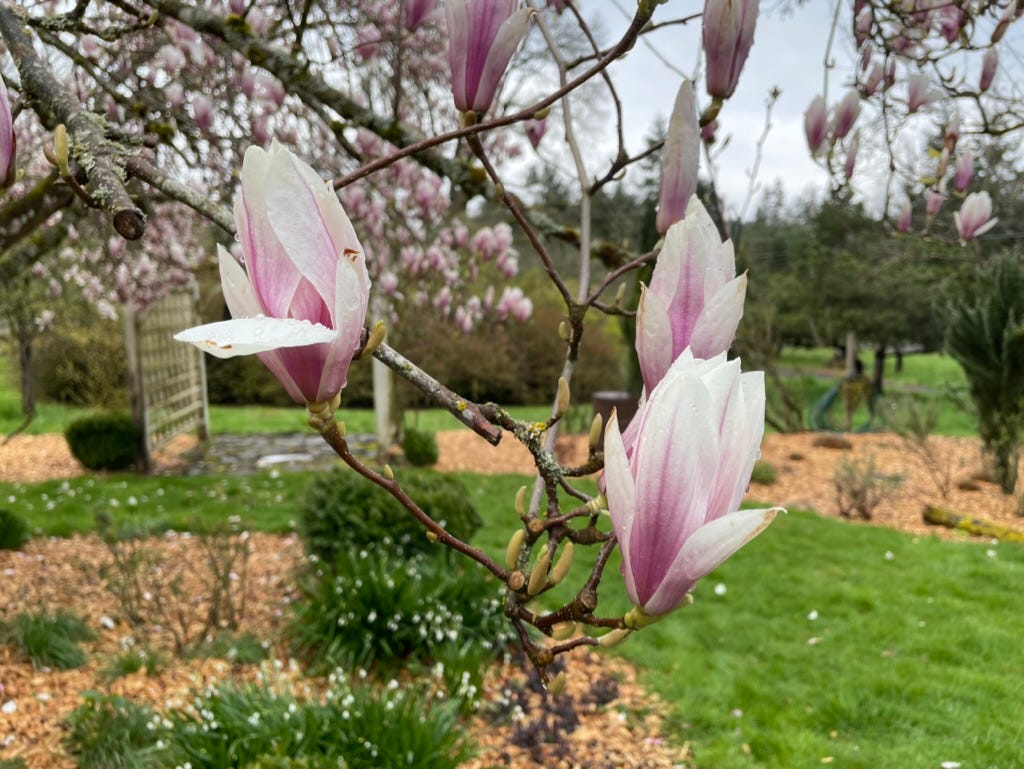This magnolia tree has lived outside the front windows of our house as long as we’ve lived here. It’s been there as long as the previous owners lived here, too, and the ones before them. As far as we can tell, people have been looking out the front windows of this house and seeing this magnolia tree since the beginning of the 20th century. They’ve seen it lose its leaves in the fall; they’ve seen it weather torrential rains and ice storms in the winter. They’ve seen the first signs of buds appear in late February and counted the days until, in what can feel like the briefest flash, those buds explode into pink and white fireworks, only to shed its pedals to the ground a few weeks later.
Here are the Schatzes, the farm’s third owners. They were tenants on the farm initially, leasing land from the second owners, the Melchers. Over time, they were able to buy pieces of the property — which at that time amounted to over 2,000 acres — until they owned the entire holding outright. I imagine that was a big deal for these newly-arrived German immigrants. The farm they’d been leasing for so long was now theirs. I like to imagine they did some upkeep in celebration. They built a rose trellis, they made plans for a new barn; they planted a magnolia tree. That’s the magnolia tree in the photo, there in the bottom right corner, with the white blooms. Supposedly. That’s what the previous owner, Paula, told us. We’ve scrutinized the photo over the years, trying to determine whether or not that really is the tree.
In any case, the Schatzes planted the magnolia tree at some point, whether or not it’s documented in a photograph. And they must’ve watched it grow and sprout limbs and every April waited for those white and pink fireworks to bloom and watched them fall a couple weeks later.
Carson and Milo went to Japan for Milo’s spring break and those buds were just starting to pop on the tree as we left for the airport, three weeks ago. Carson worried she was going to miss the show. It’s a very brief window and it only happens once a year. It’d be a shame to miss it. As it happens, it’s been a cold spring and (despite a nationwide trend in the opposite direction) all of our flowering trees seem to be taking their time. When Carson and Milo got back from Japan, those buds were still unfurling. They’re now in full show, and it’s really beautiful.
We’ve lived here for ten years now. We moved in the fall of 2013, so we’ve only seen this magnolia tree burst to bloom nine times. That seems like very few times. In between showings, it’s been a tree to climb and a tree from which to fetch stuck climbers. A tree to hide plastic easter eggs in the crooks of the boughs. A tree to marvel at when the sky was filled with smoke, and a tree to rehabilitate when an ice storm nearly destroyed it.
The Schatzes lived here for nearly a hundred years; they sold the place to the Hansons in 1983. So they got nearly a hundred yearly-showings of the pink and white blossoms, a hundred years to clock the turning of the seasons by the changing of this tree. I’m sure they had their fair share of ice and wind and fires. This magnolia tree is a survivor.
According to the internet, magnolia trees only typically live 80-120 years. If, as in my imagined version, this tree was planted in, say, 1895, it is well over its longest life cycle. So it was likely planted much later — but no so late that it couldn’t be clocked in a photo with a bunch of ghost-looking Edwardians as a shrub. All this to say: it’s likely that we’re witnessing this magnolia’s fading years. This magnolia is a senior citizen; it’s elderly. I wonder how many more cycles of bloom and shed we’ll see. Five? Ten?
As with all things, it’s better not to dwell on that. Live in the present moment, and in the present moment there is a massive tree outside our front window that has been there for over a hundred years and it is currently covered in thousands of of pink and white petals.
In other news, the box elder bug infestation in the Machine Shop (the corporeal Machine Shop, not the virtual one) has suddenly vanished. Whether this is due to the likely-carcinogenic chemical that was used to deter them or their own decision, I can’t say. While they’d been dying in droves (poor little gross fellas), their population growth seemed to be undeterred. My daily regimen for the last three months had been trudging out to my studio, dust buster in hand, to vacuum up these clingy bugs that were climbing the walls and the windows. I’d gone to such lengths as to tape the front door of the shop closed (for real), which then forced me to get into my studio through a back door via the storage shed. It was disheartening. Then, one day, I walked into the Machine Shop, prepared to send hundreds of box elder beetles to their agonizing death inside a Black and Decker handheld vacuum, and I saw they’d just up and left. Gone. Vanished.
What good fortune! Farewell, black and red bugs. I can now resume using my studio without the fear of having weird, brown-liquid-pooping insects landing in my hair while I played guitar or talked with other grown ups on a zoom conference. It’s really the little things, guys.
Till next time,
Colin Meloy
Chief Machinist












Clearly the Magnolia needs its own song. ❤️
Colin, your personal magnolia may be elderly, but magnolias as a species have changed very little since prehistoric times. A heartening thought, I hope.